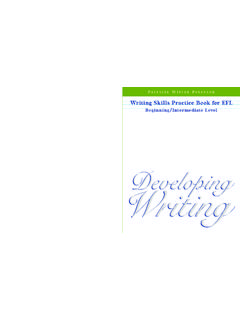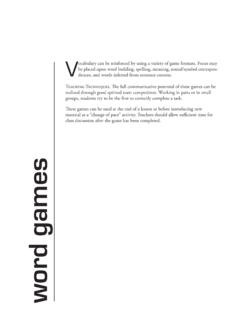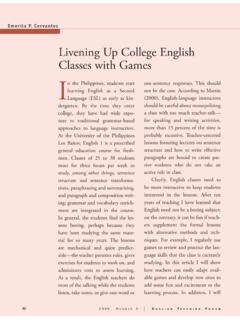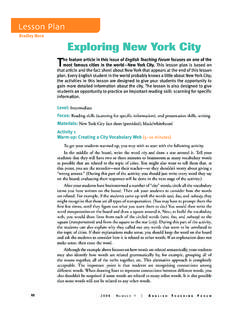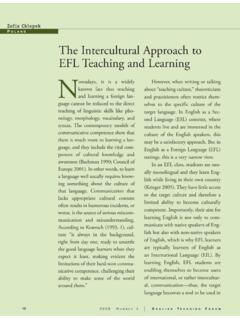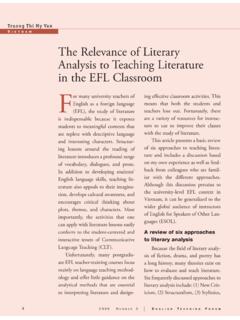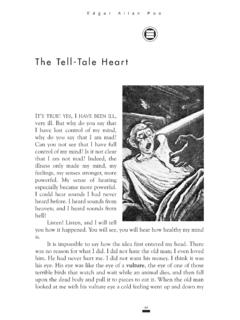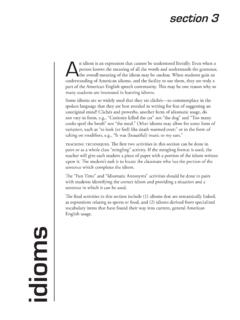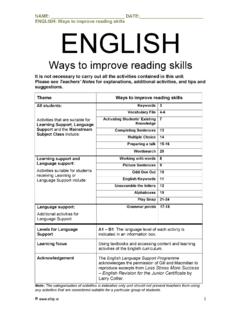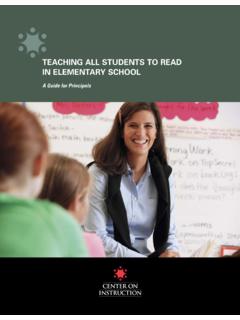Transcription of Using Concept Mapping to Teach Young EFL Learners …
1 2016 ENGLISH TEACHING TEO, YUN F. SHAW, JIMMY CHEN, AND DEREK WANGT aiwanUsing Concept Mapping to Teach Young EFL Learners reading SkillsMany English as a foreign language (EFL) students fail to be effective readers because they lack knowledge of vocabulary and appropriate reading strategies. We believe that teaching proper reading strategies can help second-language Learners overcome their reading problems, especially when the instruction begins in elementary school. Effective reading strategies provide the means to tackle complex problems in more efficient ways and allow students to build a path to comprehension (McNamara 2009, 34). One effective strategy is Concept Mapping , which is the use of visual tools to help readers understand material by transferring the written content into concrete images (Liu, Chen, and Chang 2010, 442).
2 Through Concept - Mapping activities, Learners connect previously learned and newly learned ideas onto a visual representation, or map. Research shows that Concept maps have positive effects on children s language skills ; for example, Liu et al. (2011) describe how Concept Mapping prompts Learners to reflect to construct meaning based on their observations and knowledge, thereby helping students develop and apply the knowledge about storytelling (873). In this article, we describe two reading lessons that use Concept Mapping to produce beneficial effects for elementary school students. BACKGROUNDC oncept Mapping is related to the pedagogical theory of constructivism, which asserts that productive learning occurs when students create meaning on their own by connecting previous knowledge and experience with newly formed knowledge and experience.
3 According to Kalhor and Shakibaei (2012), Concept Mapping (1) helps students understand the framework of the subject being taught; (2) clarifies the relationships and connections among all instructional content; (3) reinforces knowledge retention; and (4) enhances an instructor s teaching objectives. Anderson (1991) stresses the importance of describing reading strategies for students ( , visualization and applying background knowledge and experience) and of showing Learners how to use them. Therefore, when it comes to teaching EFL reading , it is crucial for a teacher to act as facilitator to help Learners construct their own meaning as they apply their current knowledge to new ideas. TWO Concept - Mapping LESSONSThe following two lessons are geared toward EFL elementary school children with basic 2016 ENGLISH TEACHING language proficiency at least two years of experience in learning English.
4 We paired up students in advance, and each student remained with the same partner throughout both lessons. Teachers who would like to adapt our lesson plans can make adjustments to suit the level and makeup of their classes. Concept - Mapping Lesson OneThe objective of this lesson is to Teach students to organize their ideas by drawing their own Concept maps based on a story they are already familiar with. To this end, we chose a picture book called Frozen (Scollon 2013) because the story is popular and the plot is easy for elementary school students to understand. For this lesson, teachers will need the picture book and a copy of the movie. For teachers and students who do not have access to the picture book and movie, a video book is available at Teachers will also need copies of the pre-made Concept map chart (see the Appendix), a pencil and an eraser for each student, and two pieces of paper and a set of colored pencils for each student Show the movie Frozen, which is dubbed in the students first language and contains English subtitles.
5 (An option is to show the original movie in English, with subtitles in the students first language.) We strongly suggest that teachers allow students to watch the movie a few times and follow with a discussion until students are familiar with the story. Continue the lesson by showing the picture book of Frozen to the students and then ask individual students to narrate the story following the actual sequential order of the events. 2. Introduce the idea of the Concept map by showing the students the pre-made Concept map in the Appendix. Include the four major story-element categories: (1) characters, (2) settings, (3) events, and (4) time order. Explain the meaning of each category so that the students understand what to fill in. Facilitate as the students fill in the significant elements that relate to the story. 3. Have students work in pairs to draw their own Concept maps; encourage them to be creative.
6 For example, instead of drawing a traditional Concept map as in the example, students can draw a character of their own choice from the story to be used as the topic frame. Many students in our class chose Olaf, the talking snowman in the story, as he is most students favorite character. For example, one student drew four Olafs with four different poses, and the students recorded their ideas on the Olaf heads and bodies. The heads consisted of four major categories, and the bodies were filled in with the related details. This activity promotes creativity and learner autonomy because students design Concept maps according to their own Have the students rewrite their own versions of the story on their Concept maps, adding any characters or events they create themselves. Students employ creativity when they produce a version of a story written by others; they are excited about writing their own versions, as it gives them a sense of ownership.
7 Next, the students color the Concept maps and the characters they drew. While the students create their own stories, emphasize that all the events must be recorded in proper time order; ensure that the chronological order of the events arranged by the students reflects logical progression rather than random ordering. 5. This step serves as an assessment stage. Collect and record the ideas from Step 4 and invite students to share their opinions with the class about how they organized the events in the stories. If the students events do not represent proper time sequence, show them how to connect their ideas by recording the events step-by-step on the Concept maps they created on their own in Step 4. 2016 ENGLISH TEACHING Give students time to work in pairs again to discuss the differences between others work and their own.
8 Point out how each event developed and note whether the events were arranged in proper time order. 7. Ask each pair the following questions and give pairs opportunities to answer: Did you find any differences between others Concept maps and your own? Why did you make your Concept map like this [Event A first, then Event B] instead of like this [Event B first, then Event A]? Please explain why you wanted to present your story in this way. In this step, students explain orally to the class, or to other pairs, why certain events happen before or after other events in the stories they created. The purpose is to allow them to explain or justify the time-order arrangement in their stories; this step also allows the teacher to assess students ability to arrange story events in logical order. For example, students might explain, In our story, at the beginning we put Johnny in the house instead of at school.
9 The reason is that we wanted him to meet the stray dog on his way to school. 1. Camilla Cream loves lima beans, but her friends from school don' On the first day of school, she is in the closet trying to pick an outfit to impress her Suddenly, Camilla breaks out with a bad case of The stripes turn into anything anyone Many specialists try to cure Camilla, but they only make the situation A mysterious woman comes up with a solution. She tells Camilla to eat lima Camilla is 1. Key events in A Bad Case of StripesConcept- Mapping Lesson TwoThe objectives of this lesson are to promote students ability to use their vocabulary in various contexts and to make predictions and inferences Using Concept our class, we used a picture book titled A Bad Case of Stripes (Shannon, Casserly, and Ingemi 2006).
10 This book has been published in many countries. For teachers and students who do not have access to the picture book, the video book is available at The story describes Camilla Cream, a girl who agonizes about other people s opinion of her and anxiously tries to please everyone. She goes to great lengths to impress her friends, even to the point of giving up eating lima beans, her favorite food. We chose this book because there are many elements in the story that support making predictions and inferences. In addition to the storybook, the materials needed for the lesson are a pencil and eraser and several pieces of paper for each student; a pre-made chart showing key events in the story (Figure 1); copies of a Concept map for making predictions (Figure 2); and copies of a Concept map for making inferences (Figure 3).
